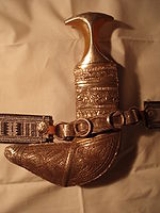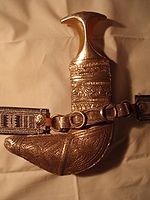
Khanjar
Encyclopedia

Dagger
A dagger is a fighting knife with a sharp point designed or capable of being used as a thrusting or stabbing weapon. The design dates to human prehistory, and daggers have been used throughout human experience to the modern day in close combat confrontations...
of Oman
Oman
Oman , officially called the Sultanate of Oman , is an Arab state in southwest Asia on the southeast coast of the Arabian Peninsula. It is bordered by the United Arab Emirates to the northwest, Saudi Arabia to the west, and Yemen to the southwest. The coast is formed by the Arabian Sea on the...
. It is similar to the Yemeni jambiya
Jambiya
Janbiya, also spelt janbia, jambiya, and jambia, , is the Arabic term for dagger, but it is generally used to describe a specific type of dagger with a short curved blade that is worn on a belt. Although the term jambiya is also used in other Arab countries, it is mostly associated with people of...
.
The khanjar is curved and sharpened on both edges. It is carried in a sheath
Sheath
Sheath may refer to:* Scabbard, a sheath for holding a sword, knife, or other large blade, as well as guns, such as rifles.* The outer covering of a cable* Condom, a kind of contraception* Debye sheath, a layer of a plasma in physics...
decorated in silver
Silver
Silver is a metallic chemical element with the chemical symbol Ag and atomic number 47. A soft, white, lustrous transition metal, it has the highest electrical conductivity of any element and the highest thermal conductivity of any metal...
, on a belt similarly decorated in silver filigree
Filigree
Filigree is a delicate kind of jewellery metalwork made with twisted threads usually of gold and silver or stitching of the same curving motifs. It often suggests lace, and in recent centuries remains popular in Indian and other Asian metalwork, and French from 1660 to the late 19th century...
.
A khanjar appears on the flag of Oman
Flag of Oman
The national flag of Oman consists of three stripes with a red bar on the left that contains the national emblem of Oman. The white stands for peace and prosperity, the green for fertility and the Green Mountains, and the red for battles against foreign invaders...
, as part of the national emblem of Oman
National emblem of Oman
The national emblem of Oman consists of a khanjar dagger in a sheath that is superimposed upon two crossed swords. This is the traditional symbol of Oman. It is found on numerous flags as well as the currency of Oman and on the planes of the Omani Air Force, among other locations....
.
There are many uses of the Khanjar it is a symbolic weapon and worn by men after puberty. Nowadays it is used as a type of formal dress code and stylistic purposes. The release of the Khanjar from its sheath before the 1970s was considered a social taboo and men would only do that if they sought revenge or assassination.
The Khanjar can be found anywhere from Egypt
Egypt
Egypt , officially the Arab Republic of Egypt, Arabic: , is a country mainly in North Africa, with the Sinai Peninsula forming a land bridge in Southwest Asia. Egypt is thus a transcontinental country, and a major power in Africa, the Mediterranean Basin, the Middle East and the Muslim world...
to Iran
Iran
Iran , officially the Islamic Republic of Iran , is a country in Southern and Western Asia. The name "Iran" has been in use natively since the Sassanian era and came into use internationally in 1935, before which the country was known to the Western world as Persia...
under the same name.
See also
- KhandaKhanda (sword)The blade is usually broad and quite heavy and broadens from the hilt to the tip. The blade transforms into tip rather abruptly. The hilt has a small metal spike coming out in the opposite direction typical of the khanda...
- FirangiFirangi (sword)The firangi derived from the Arabic term for a Western European [a "Frank"]) was an Indian sword type which used blades manufactured in Western Europe and imported by the Portuguese, or made locally in imitation of European blades.-Physical characteristics:...
- SabreSabreThe sabre or saber is a kind of backsword that usually has a curved, single-edged blade and a rather large hand guard, covering the knuckles of the hand as well as the thumb and forefinger...
- PulwarPulwarA pulwar is a single handed curved sword from Afghanistan and neighbouring regions of Pakistan and Northwestern India.-Characteristics:...
- ShamshirShamshirA Shamshir also Shamsheer and Chimchir, is a type of sabre with a curve that is considered radical for a sword: 5 to 15 degrees from tip to tip. The name is derived from Persian شمشیر shamshīr, which means "sword"...
- KilijKilijA kilij is a type of saber used by the Turks throughout history starting from late Hsiung-nu period to Avar Empire and Göktürk Khaganate, Uyghur Khaganate, Seljuk Empire, Timurid Empire, Mamluk Empire, Ottoman Empire, and later Turkic Khanates of Central Asia...
- SaifScimitarA scimitar is a backsword or sabre with a curved blade, originating in Southwest Asia .The Arabic term saif translates to "sword" in general, but is normally taken to refer to the scimitar type of curved backsword in particular.The curved sword or "scimitar" was widespread throughout the Muslim...
- ZulfiqarZulfiqarZulfiqar "bifurcated" is the sword of the Islamic leader Ali. In Arabic the name is commonly transliterated as Dhu al-Fiqar, Thulfeqar, Dhulfiqar, Zoulfikar etc. The name Zulfiqar means which divides exactly in two parts....
- Tatbir

